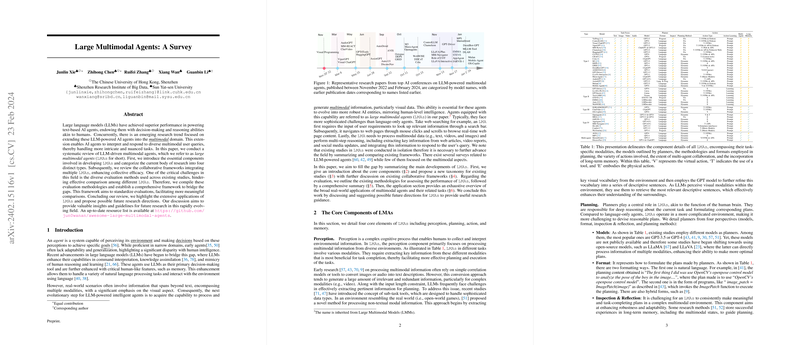Systematic Review and Future Directions for Large Multimodal Agents Powered by LLMs
Introduction
The introduction highlights the pivotal role of LLMs in enhancing the functionality of AI agents, particularly in decision-making and reasoning tasks that closely mimic human capabilities. With the evolving landscape of AI demands, the introduction of multimodal capabilities in agents—referred to as Large Multimodal Agents (LMAs)—promises a transformative shift towards handling more sophisticated and nuanced tasks across different modalities including text, images, and videos. The paper systematically reviews the existing body of work on LMAs, categorizes them based on functionality, and explores collaborative frameworks that enhance their collective efficacy, addressing challenges in evaluation methods and defining comprehensive frameworks to aid meaningful comparisons and promote future research endeavors.
Core Components of LMA Development
Perception
Perception modules are responsible for multimodal data processing, extracting and interpreting useful information from varied inputs such as images, video, and audio to facilitate efficient decision-making. Recent advancements are noted in their ability to handle sophisticated data inputs which significantly enhances their utility in real-world scenarios.
Planning and Decision Making
The planning aspect reviews existing planners across models, formats, and methodologies, showcasing their critical role in strategy formulation and decision-making. Current systems rely heavily on proprietary models like GPT-3.5 and GPT-4. Comparative analysis between static and dynamic planning methodologies underscores the tendency towards dynamic planning for error adjustment during tasks.
Action Execution
Action components classify into tool use, embodied actions, and virtual interactions with systems. It extensively covers the range of existing actions derived from task execution, showing a trend towards sophisticated methodological implementations that can span across real and virtual environments.
Memory Systems
Discussion on memory systems in LMAs indicates an emerging trend towards integrating long-term memory capabilities, enhancing their functionality in complex task environments. This integration aids in storing and retrieving experiences or data, improving task accuracy and efficiency.
LMA Categorization and Taxonomy
The paper introduces an innovative taxonomy categorizing LMAs into four distinct types primarily based on their planning capabilities and memory integration. From closed-source LLMs acting as basic planners without memory functionality to advanced systems featuring interactive long-term memory, the taxonomy provides a structured framework reflecting the evolutionary advancements in LMA development.
Collaborative Frameworks
Expanding beyond single-agent models, the review discusses multi-agent collaboration, providing insights into frameworks that involve multiple LMAs working synergistically. This segment highlights the importance of role differentiation and strategic task distribution among agents to optimize collective performance in complex scenarios.
Evaluation Strategies
A critical analysis of existing evaluation methodologies for LMAs is presented, revealing a gap in comprehensive and standardized evaluation frameworks. It promotes the development of rigorous, scenario-specific benchmarks that can effectively measure the functionality and performance of LMAs across various tasks.
Practical Applications and Real-World Utility
This section elucidates the extensive applications of LMAs, from GUI automation and robotics to complex reasoning tasks and autonomous systems. It underscores their potential in revolutionizing various industry sectors by providing sophisticated, multimodal task-handling capabilities.
Conclusions and Future Directions
The paper concludes with a thoughtful examination of current challenges and potential future directions in LMA research. It emphasizes the need for unified systems with direct memory manipulation, improved collaborative multi-agent frameworks, more robust evaluation mechanisms, and expanded real-world applications. The conclusion serves as a call to action for the research community to address these challenges and harness the full potential of LMAs in advancing AI technology.
